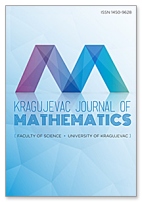Vertical Time: Sound and Vision
 Download PDF
Download PDF
Authors: N. SAULIG
DOI: 10.46793/KgJMat2307.1065S
Abstract:
The concept of poetic time, experienced through poetry, music and plastic arts, has firstly been individuated by Gaston Bachelard in the 1930s. The spectator’s sensation of time rupture and ecstasy has been defined as time rearrangement into a vertical structure, linking to eternity. Although this particular perception of time has been described as triggered by spectator’s experience of sublime art forms, this paper finds earlier evidence of the phenomenon in Giacomo Leopardi’s poem L’Infinito (1819), as result of nature contemplation. Analysis of the sound that induces the vision of vertical time in Leopardi’s poetry is performed by signal processing techniques. Relations between time, frequency and lag representations of the signal are established, finding correspondence of the signal power spectral density and time verticality in the lag domain.
Keywords:
Vertical time, spectral analysis, white noise, delta function.
References:
[1] G. Bachelard, The Dialectic of Duration, Clinamen Press, Manchester, 2000.
[2] G. Bachelard, Intuition of the Instant, Northwestern University Press, Evanston, 2013.
[3] R. Barzanti, Su “l’infinito”: l’idillio senza figure, IL PONTE Anno LXXVI 4 (2020), 96–118.
[4] D. Buzzati, Il Deserto dei Tartari, Collana “Il Sofà delle Muse”, No. 1, Rizzoli, Milano-Roma, 1940.
[5] R. Cantarella, Letteratura Greca, Società editrice Dante Alighieri, Roma, 1985.
[6] L. W. Couch, Digital & Analog Communication Systems, 8th edition, Pearson, 2013.
[7] G. Leopardi, Versi del Conte Giacomo Leopardi, Stamperia delle Muse, Bologna, 1826.
[8] G. Leopardi, Opere, Unione tipographica-editrice torinese, De Agostini Libri, Novara, 2013.
[9] G. Leopardi, Zibaldone, Farrar, Strauss and Giroux, New York, 2013.
[10] D. Messina, Blind windows: Leopardi with Rothko, Nineteenth-Century Contexts 41 (2019), 51–62. https://doi.org/10.1080/08905495.2018.1545428
[11] M. Milovanović, I. Kuletin Ćulafić and N. Saulig, Vertical time in arts, 2023 (submitted to Mathematics).
[12] M. Milovanović and B. M. Tomić, Fractality and self-organization in the orthodox iconography, Complexity 21 (2015), 55–68. https://doi.org/10.48550/arXiv.2004.08976
[13] K. E. Oughstun, Electromagnetic and Optical Pulse Propagation, Springer, Cham, 2019.
[14] D. Purves, G. Augustine, D. Fitzpatrick, L. Katz, A.-S. LaMantia, J. McNamara and S.M. Williams, Neuroscience, 3rd Edition, Sinauer Associates, Sunderland, 2004.
[15] R. P. Resch, Althusser and the Renewal of Marxist Social Theory, Berkeley, University of California Press, Berkeley, 1992.
[16] B. Sklar, Digital Communication: Fundamentals and Applications, 2nd edition, Prentice hall, New Jersey, 2001.
[17] C. Stanco, Recanati Colle dell’Infinito vista campagna.jpg, (2020, August 28), Wikimedia Commons, the free media repository.
[18] Ž. Milanović, N. Saulig, I. Marasović and D. Seršić, Spectrogram-based assessment of small SNR variations, with application to medical electrodes, EURASIP Journal on Advances in Signal Processing 2019 (2019), 1–14. https://doi.org/10.1186/s13634-019-0634-4
[19] J. Wiskus, Inhabited time: Couperin’ passacaille, in: A.-T. Tymieniecka (Ed.), Logos of Phenomenology and Phenomenology of The Logos. Book Three, Logos of History - Logos of Life, Historicity, Time, Nature, Communication, Consciousness, Alterity, Culture, Springer, Dordrecht, 2006, 177–193.
